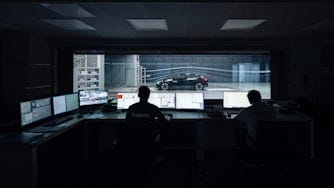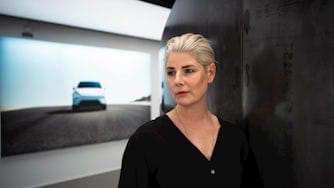The world’s coldest classroom: Polestar 2 testing in Jokkmokk
Tests. Introduced to us when we’re schoolchildren, tests are almost universally thought of with distaste. They recall memories of anxiety, of late-night study sessions, of an all-consuming fear of failure. Tests, simply put, are the worst. Joakim Rydholm is doing his best to change that.
Piloting a Polestar 2 over the snow and ice of Jokkmokk, Rydholm is taking a test just as surely as any student confined to a classroom. He’s measuring the various capabilities of Polestar 2 north of the Arctic Circle. Seeing how the all-electric fastback performs under extreme conditions is a large part of Rydholm’s duties as a chassis engineer and test driver. His is the face that flies by in various Polestar prototypes the world over, from English country lanes to Spain’s sun-baked tarmac, almost always sporting a grin which is the polar (get it) opposite of the frowns normally associated with test taking.
These tests involve everything from checking how the car steers after a night spent at -30°C, to the balance between front and rear axles while driving on ice, and everything in between. Nothing escapes the attention of Rydholm and the team, down to the molecular level. “Oil has a higher density at colder temperatures, so the Öhlins dampers need to be tested to see that they work optimally and without noise,” explains Rydholm.
Jokkmokk, with its inland location in northern Sweden’s Norrbotten county, is the ideal place for these tests. And it’s not the first time for Rydholm either, as his winter runs with Polestar stretch back to the days when the Polestar 1 prototype was put through its polar paces.
“It’s cold up here, of course,” laughs Rydholm. “But the temperature varies from day to day. In order to accurately run tests, we need to be able to repeat them under the same conditions.” Which is why the team makes use of the cold chamber: a climate-controlled, 6 m by 3 m box in which the temperature can be lowered to and held at -30°C. Handling, comfort, ice, and split friction tracks (on which one set of wheels ride on ice and the other on asphalt) compliment the full suite of testing facilities in the Arctic Circle location.












01/06
When asked for winter driving tips, Rydholm responded by emphasising the importance of the climate timers. “The heating system uses energy to heat the cabin as well as the battery,” he states. “So you should pre-climatise the car in order to increase efficiency, ideally when plugged in.” He also stresses that winter driving uses more energy anyway, due to the increased rolling resistance caused by snow and mud. “Otherwise, drive it like a normal car,” he continues. “That’s why we do these tests, after all.”
Of course, Rydholm found a way to make what was an already fun assignment even more thrilling: an experimental, “winter rally” version of Polestar 2. One with a 30 mm higher ride height, 30% reduced spring rate, four extra lights for the polar darkness, a carbon fibre “snow shovel” (not kidding) in the trunk, tyres sporting 490 4 mm studs, and a steering wheel paddle-assisted launch control system. Clad in a matte grey and white livery, with Swedish gold accented Recaro seats, this one-off version of Polestar 2 is uniquely distinctive and unquestionably Polestar.
“I wanted to have more fun than usual with this car. The balance and predictability we have achieved with the raised ride height and specialised tyres are particularly noticeable when you enter a bend completely sideways, with a bigger-than-usual smile on your face, and in total control,” concludes Rydholm.
The mention of a test can still send a chill up the spine of many. For Rydholm, the chill is what he enjoys the most.


